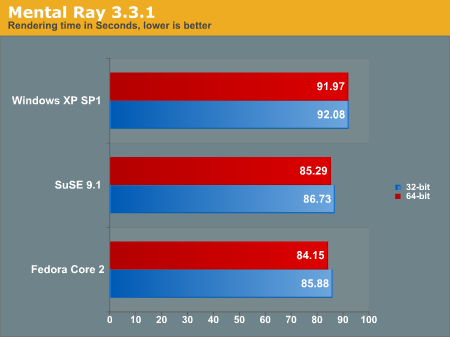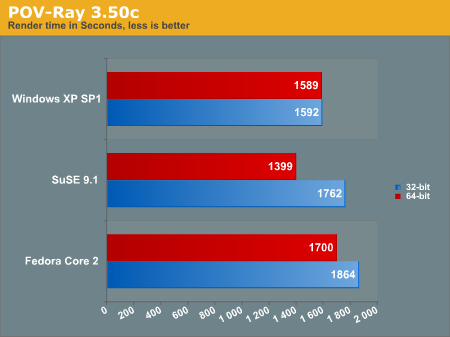AMD and Linux: Reaching for the 64-bit Trophy
by Kristopher Kubicki on July 12, 2004 12:05 AM EST- Posted in
- Linux
3D Rendering
Mental Ray is the crème of the crop as far as 3D rendering programs go. We only had access to a 32-bit version of the renderer for Linux and Windows, so we used that for this portion of the benchmark. We used Mental Ray 3.3.1 for this particular benchmark. You may view the scene that we rendered in our analysis here.Rendering time, lower is better.

Like our other encode tests, the Mental Ray renders proved to produce consistant times reliably within 1/10 of a second in extreme cases. We find some of our most significant test cases of Linux outperforming Windows.
POV RAY
Although POV RAY is limited in application (particularly when compared against Mental Ray), it does provide a free open source solution for basic rendering. Again, we had to use 32-bit binaries for the Win-64 beta. POV-Ray 3.50c was our choice of a render engine for this benchmark. For benchmark specifics, we run the exact benchmark as specified by the POV-Ray official site. Update: As of today, POV-ray just released a 64-bit Windows binary release candidate. We were not able to run them in time to fit our publication date, but feel free to check the new binaries out here.Render Time in Second, less is better.











29 Comments
View All Comments
KristopherKubicki - Monday, July 12, 2004 - link
tsadowski: Its actually pretty clean. I wouldnt compare it to Gentoo at all. Thats probably also why it has an RPM repository - so you CAN work with it out of the box.Kristopher
tsadowski - Monday, July 12, 2004 - link
I find it interesting that you test Fedora Core 2 and expect it all to just work perfectly. Is Fedora not the bleeding edge code, hack it yourself, hobbyist version of RedHat? Not unlike Gentoo? To expect it to just work "out of the box" without some hacking is foolish at least, and at worst perhaps an intentional attempt to slander Fedora/Redhat? I have played around with Fedora Core 1 and while I wouldn't say that it is the best distro I have ever used. I wouldn't bad mouth it without acknowleging it's hackerish, homebrewish nature either!jspaleta - Monday, July 12, 2004 - link
#15along with the flags, the specific versions that you compiled would be good to know. Actually since its compiled I would be interested to know if you had to install/compile any additional build requirements beyond what is available in Fedora Core as well.
I would also be interesting if you could rerun the
lame encoding benchmark against the lame build currently available in the stable x86_64 fc2 rpm.livna.org repo, as a comparison.
-jef
KristopherKubicki - Monday, July 12, 2004 - link
#8, 14: lame and mplayer are compiled. I will get the exact flags and details posted soon.#8 again: SuSE gives you two options for installing the drivers - manually, as we did or via YAST. I just chmod 0 /usr/X11R6/bin/X, ctrl-alt-backspace and then run the driver. You can also hit F2 during startup and tell it to go into "failsafe" mode.
#10: Thanks Matt, id like to work closer with MS to get that. I have a feeling Intel's compiler will show up for x86_64 soon, being as nocona is available now.
Kristopher
jspaleta - Monday, July 12, 2004 - link
I would like to know from where the reviewersgot fedora binaries for memcoder, mplayer and lame for fedora core. These untilies do NOT come as part of Fedora Core, are not built by the Fedora Core buildsytem, and can be obtained from a number of different repositories. I would personally like to know if different builds of mplayer/mencoder/lame from different locations experience different results.
-jef
lopri - Tuesday, April 28, 2009 - link
asdfTerm - Monday, July 12, 2004 - link
Out-of-the-box the video-drivers for Linux from NVidia have Fast Writes disabled, but you have enabled it right?damn good article btw
// Term
Possessed Freak - Monday, July 12, 2004 - link
Errors on graphs:Why are the key color orders reversed. Shouldn't red/64bit be on top in the key?
Why does the order of the OS's change seemingly randomly in the graphs? I thought it might deal with performance, but I could not see a relation.
Regardless, good article.
LostInSpace927 - Monday, July 12, 2004 - link
I am thinking someone needs to a little research before typing an article."Unfortunately, you can't even try the Personal version of SuSE 9.1 without forking the $90 because the Personal edition does not ship with a x86-64 kernel."
I downloaded SuSE 9.1 free od charge from www.linuxISO.com.
All the longer it took me to find this was a few seconds googling.
Matthew Daws - Monday, July 12, 2004 - link
To say that there is no 64-bit compiler for Win64 is slightly untrue: a CPUID.com article uses a beta VC++ 8.0 from the "Microsoft DDK for Windows Server 2003" CD. Sadly, it produces awful code from C++ and cannot optimise less common FPU functions. So, in that sense, there isn't a compiler capable of compiling a whole application: simple benchmarks are possible though (and show 5-35% speed increase, due to more registers mainly).Thanks for a good article! --Matt